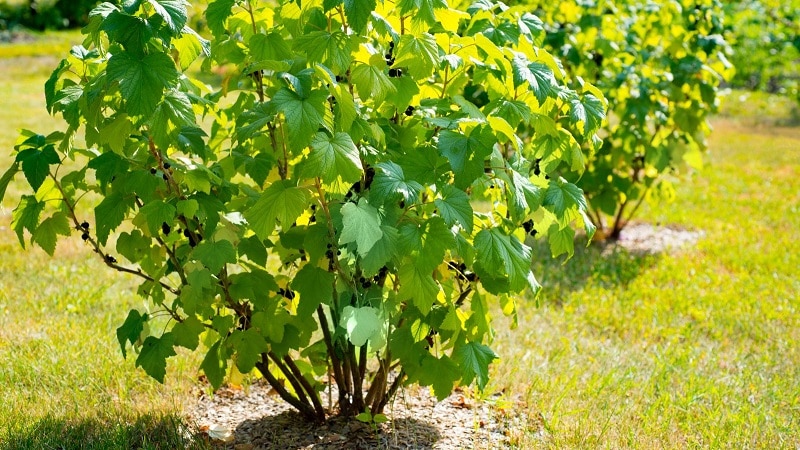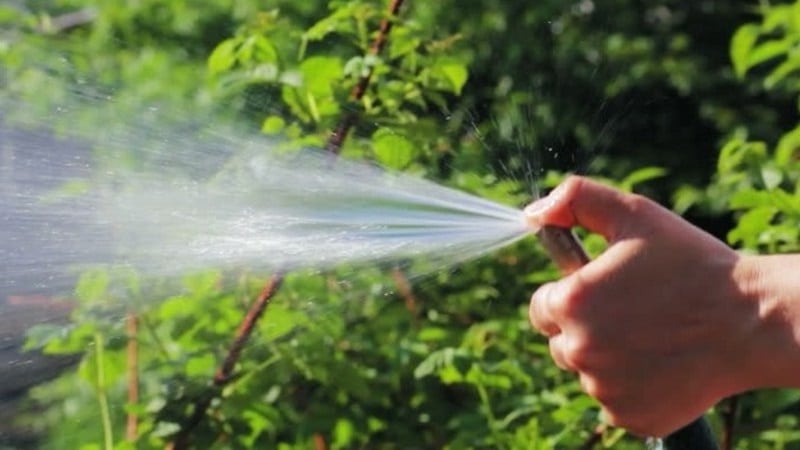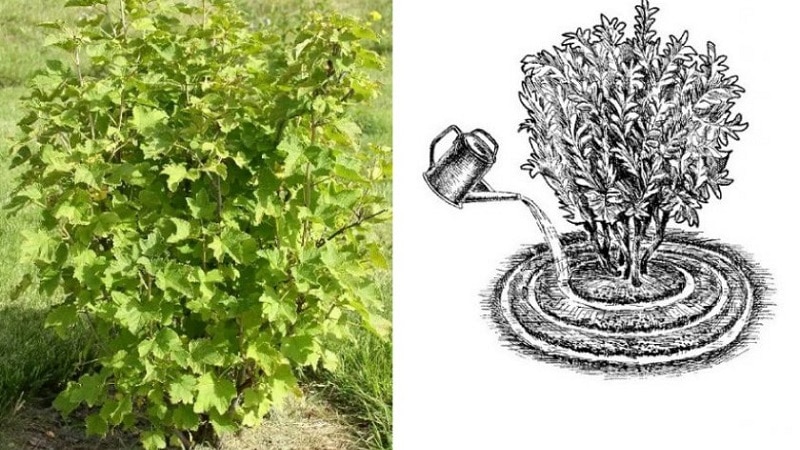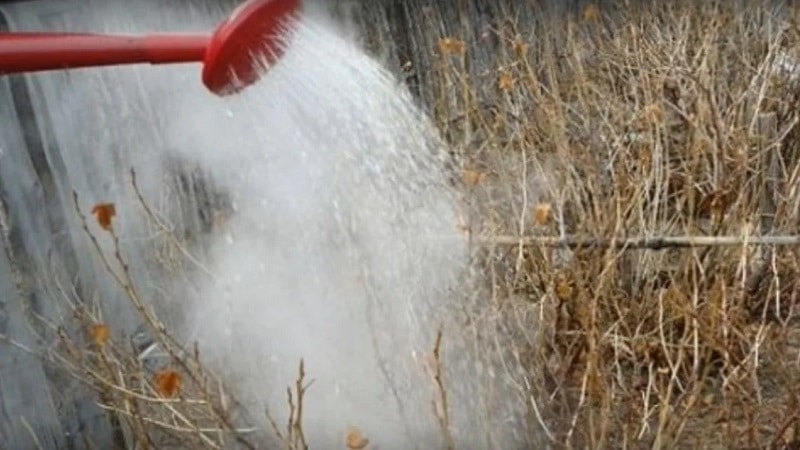A complete guide to watering currants for healthy bushes and a bountiful harvest.
A moisture-loving crop - currants - under natural conditions prefers places with moist soil (in lowlands, floodplains). In order for the plant to be healthy and bear fruit well, it and the garden plot must be provided with timely watering at different times of the year. Find out how often you need to water the crop from the article.
Basic rules for watering currants
Currant roots, located close to the soil surface, are not able to absorb moisture from great depths. Therefore, the plant needs regular and moderate watering. It should be taken into account that excessive soil moisture is just as harmful to berry bushes as drought.
Not receiving enough water, the currant reacts instantly: the leaf blades curl and dry, the ovary does not form. If fruits have already formed on the crop, they may fall off before ripening. At best, the harvest of small berries will not be marketable. In addition, their sour taste will be far from ideal.

If during a drought period the plant is not provided with timely watering, its development will stop. Young shoots will stop growing, and the plant itself may die in unfavorable conditions.
Excess water in the soil causes rotting of the root system. Increased moisture provokes the development of fungal and bacterial infections that threaten the health of the bush.
Attention! For berry crops, the optimal soil moisture level is about 60%.
Symptoms of lack and excess moisture
Water is necessary for normal vegetation of almost all crops. Processes important for plant life (photosynthesis, obtaining nutrients) occur with sufficient soil moisture.
The lack of water in the soil can be easily determined even by the condition of the crown. Currant leaves turn yellow gradually curl up, wither and fall off along with the ovary ahead of time. The stems of young shoots become sluggish and stop growing. If the soil has dried out 15 cm deep, this indicates that the plant needs watering.
If the soil is excessively moistened, the crown of the berry crop turns pale, because the roots do not breathe, and the process of photosynthesis is disrupted. Without receiving nutrition from the soil, the plant withers and may die if measures are not taken in time.
In regions with sufficient precipitation, a situation where the soil completely dries out rarely occurs. Therefore, you should control the humidity level so as not to harm the shrub. In the southern regions of the country, watering is carried out frequently to create comfortable conditions for the fruit crop to form a harvest.
Attention! If a handful of earth, squeezed in your hand, crumbles, this means that the soil is dry. Moderately moist soil is easy to compress, but does not clump together.
How to water currants correctly
A well-groomed berry bush develops quickly and bears fruit abundantly. However, for this it needs sufficient and timely watering.
How often
Throughout the season, depending on the time of year and the growing season, the fruit plant needs different amounts of water.

The first watering of currants is carried out in early spring to awaken the bushes and feed them with mineral complexes.To do this, use warm water at the rate of 20-30 liters for each adult bush. For young seedlings, 10-15 liters is enough.
Experienced summer residents regulate summer watering based on weather conditions and the amount of precipitation. On hot, sultry days, the soil in the tree trunk circle of the bush is moistened at least once every 7-10 days. The plant needs especially careful care during the phases of budding, flowering, ovary formation and harvest ripening.
A lack of moisture leads to the fact that the crop, not receiving nutrition from the soil, begins to get sick. The leaves and ovary fall off, and the plant itself may die. Lack of moisture has a particularly critical effect on the health and development of young seedlings under 3 years of age.
If the summer is dry and hot, the berry bush needs to moisten the soil even after harvesting. A normal level of moisture in the soil will provide the roots with the necessary nutrition and help the bushes quickly regain strength. This is especially important if fruiting was abundant.
Attention! Even after harvesting, currants need regular watering. Proper care will help the plant form vegetative buds, on which fruiting next year depends.
Water requirements
To water the fruit crop, it is advisable to use rainwater collected in tanks. Tap water is also suitable, but for this purpose it is advisable to defend it. On the site, you can install various containers in different places in which the water will be heated by the sun's rays during the day.
Attention! Settled and slightly warm water will not harm the root system and will allow the bush to continuously receive the necessary nutrition.
Watering methods
The moisture-loving crop prefers irrigation by sprinkling, because...This technique allows you to moisten the soil evenly. For the procedure, special devices are used to disperse moisture over the bush.
Watering with a hose in the near-trunk zone of a plant is extremely undesirable, since it leads to hypothermia of the roots located close to the soil surface. Cold water provokes the development of dangerous fungal diseases. Rotting of the root system can destroy the plant.
The most optimal way to moisten the soil is by drip. With it, it is impossible to flood the roots and at the same time the plants receive sufficient water. If there are no special devices, it is easy to water manually once a week. To do this, make shallow (7-10 cm) grooves around the bush with a hoe so that the moisture does not spread, but directly feeds the roots of the plant.

The nuances of watering currants at different times of the year
The watering procedure also depends on the type of currant (black, red, white), the age of the bushes, and the growing season. The amount of moisture consumed may vary; this nuance must be taken into account in order not to get into trouble.
For different types of currants
Regardless of the color of the fruit, different types of currants require the same care, including watering. The color of the berries matters only in a gastronomic sense.
For different ages and periods
Seedlings up to 3 years old require the most careful care. The poorly developed root system of these bushes must receive moisture regularly. To prevent the soil in the tree trunk area from drying out quickly, experienced gardeners loosen it and then mulch it. This technique allows you to protect the root system from cooling and overheating. In addition, water from the soil under a layer of mulch evaporates more slowly.
Mature, hardier bushes also need regular watering, which is carried out according to a schedule, taking into account climatic conditions. The soil is moistened using irrigation systems or done manually in the morning or evening hours.
During flowering and ripening of berries, plants are given special attention. However, this does not mean that the shrub necessarily needs in abundant watering. This procedure is carried out as usual, not forgetting to take into account weather conditions and soil composition.
What to add to water
Soft, lukewarm water does not require any special additives. However, watering is often combined with the feeding procedure. At the same time, the soil must be moistened abundantly.
Fertilizers are dissolved according to the instructions and added to the water intended for irrigation. In warm and dry seasons, the roots absorb nutrient solutions along with moisture more easily.
Watering currants with boiling water
This event is one of the first to be carried out: as soon as the snow has melted, and the process of sap flow in the plants has not yet begun. It is important to have time to do everything before the buds begin to swell. Typically this period occurs at the end of March - beginning of April (depending on the region).

To process the shrubs, heat the water to +70...+80°C and pour it into ordinary garden watering cans. Then, before the moisture has time to cool, they sprinkle along the crown of the bush, trying to irrigate all the shoots evenly. A few crystals of potassium permanganate added to the water will enhance the effect of the procedure.
Spring treatment of currants with boiling water has the following goals:
- destruction of pathogens of fungal and bacterial infections;
- ridding the plant of adult insects and their larvae that have overwintered in the upper layers of soil or plant debris;
- warming the top layer of soil, promoting early vegetation.
The procedure is carried out before the plant wakes up and its shoots begin to grow. However, it must be taken into account that for hot sprinkling the period is chosen when the threat of return spring frosts has passed.
Interesting things on the site:
How and what to feed currants in June
Useful tips from experienced summer residents
The experience of Russian gardeners cultivating currants dates back centuries. Therefore, experienced summer residents willingly share useful recommendations with beginners.
Not all garden plots are equipped with modern irrigation systems. To make it easier to care for the berry crop, the soil in the root zone of the bush is freed from weeds. The moistened and loosened soil is covered with mulch. This layer (5-7 cm) may consist of mature compost, humus, coarse sand, mown grass, hay, etc.
Attention! Mulching protects the soil from weeds, erosion, overheating, cooling and drying out.
Mistakes to Avoid
Beginner gardeners sometimes make the mistake of thinking that the more moisture and fertilizer the plant receives, the better the result will be. However, excesses of both always negatively affect the health of the bush and the harvest.
If you are in doubt whether a berry crop needs watering, this can be determined in a simple way. Stick a shovel into the ground to the depth of a bayonet. If the top layer of soil has dried out by 10-15 cm, adult plants need to be watered at the rate of 40 l/sq.m. m. For young seedlings, this norm should be halved.
When using mulching, it is necessary to ensure that the protective layer is not too high and does not cake.In addition, it cannot be laid out in close proximity to plant trunks. Close contact with mulch can cause the development of diseases.
Conclusion
Even moisture-loving plants need moderate watering. In order for the plant to be healthy and delight you with generous harvests year after year, proper care is necessary. To do this, it is enough to monitor weather changes, soil conditions and use the advice of experienced gardeners.